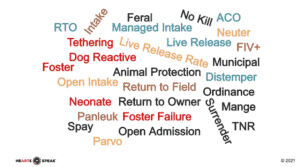 Let’s face it: If we all had kennels full of fuzzy munchkins with perfect manners and zero health problems, we probably wouldn’t need to talk about long-stay pets. But for most organizations, there are always a handful of pets with behavioral, medical or public perception challenges that make finding adoptable homes more difficult. With a little creative thinking, lots of transparency and some willingness to experiment with promotional efforts, even seemingly undesirable pets can land loving homes.
Let’s face it: If we all had kennels full of fuzzy munchkins with perfect manners and zero health problems, we probably wouldn’t need to talk about long-stay pets. But for most organizations, there are always a handful of pets with behavioral, medical or public perception challenges that make finding adoptable homes more difficult. With a little creative thinking, lots of transparency and some willingness to experiment with promotional efforts, even seemingly undesirable pets can land loving homes.
In a presentation for the Best Friends National Conference this week, Tori Fugate, KC Pet Project’s Chief Communications Officer, and I dove into a fast-paced 25-minute presentation filled with successful campaigns and ideas for shining a light on the pets who need it most. Here are some of our favorite tips and examples:
Use imagery to build a connection
From video clips to photos, the images we choose open the door to learning more.
- Showing pets in foster homes and outside the kennel or cage will help people imagine what that pet will be like in their home.
- Photographing people + pets together is a magical combination
- Show diversity in your images and ensure all community members feel welcomed
- Use alt-text captions on websites and social platforms
- Research shows that video can make potential adopters feel like they are getting to know the animal more, and allow you to explain health and behavior complexities in a way that writing about them may not allow.
Words matter: Choose them Wisely
The words we use can make or break a connection with a longtimer or overlooked pet. By considering our audience and making sure that we are speaking to them in a way that invites conversation and questions, we can fight the intimidation or uncertainty they might otherwise feel about pet adoption.

- Invest time in training volunteers to help with bios and collect information from front-line staff
- Don’t shy away from transparency and humor to build connections and generate trust.
- Be cognizant that you’re not using “animal welfare terms” in your marketing that people may not understand. Eliminate jargon and you immediately make information more accessible and welcoming
- Use language that talks about the pet’s obvious struggle but tell people how they can help — give them hope or humor, or a bit of both.
- Are you in a bilingual community? Look at options for translating and reinforcing the message that pet adoption is for everyone.
Focus on pets as individuals

Promote your pets just as pets rather than as difficult cases. Sometimes by anticipating that an animal may be harder to place, it becomes a self-fulfilling prophecy.
- There will be people who are interested in those that are harder to place. They want pets with stories, so tell them (just don’t overdramatize! Stick to the facts and compassion, but remain a trusted source of transparent information)
- Make sure these pets are visible in your shelter (ex: don’t hide FIV / FeLV cats in the back, put ‘em right up front!)
- Adoption Specials: Avoid doing specials that target only certain populations (ie black dogs, pit bulls). Instead, open them up for more animals to benefit by focusing them on weight or age! Celebrate success, set aside fear
- You can be ruthlessly honest and humorous, or heartfelt and earnest — both approaches work, just don’t overuse any single strategy
And Finally: “Treatment without prevention is simply unsustainable” – Bill Gates
 Perhaps the biggest solution for long-stay pets is to try and keep pets with their owners before they have to enter the shelter. Many pets that eventually become longtimers could be pets that didn’t have to come to your shelter in the first place.
Perhaps the biggest solution for long-stay pets is to try and keep pets with their owners before they have to enter the shelter. Many pets that eventually become longtimers could be pets that didn’t have to come to your shelter in the first place.
- Provide rehoming support using Home to Home or Rehome
- Provide lost and found support using volunteer advocates on Next Door and Facebook
- Evaluate costs of caring for the pet in your shelter vs. helping them stay with their families, then mobilize programs and funders to support medical and behavioral support for pet owners
- Educate on community cats and kittens: When to get help, when to leave them
-
Bonus Tip: Ensure you’ve shut down barriers to placement for your long-stay pets by making your adoption policies as open and welcoming as possible LEARN MORE
Recommended Reading:
How to Get Your Long Stay Dogs Adopted, or Fostered, Faster | American Pets Alive! / Human Animal Support Services
Presentation Slides: Successfully Marketing Hard to Place Pets | Tori Fugate + Caitlin Quinn
Adopter’s Welcome: Marketing that Overcomes Barriers | Humane Pro
Focus on the Present, Not on the Past, to Get Pets Adopted | Maddie’s Fund
Marketing is Not Adoption Counseling | Animal Farm Foundation
Adoption Promotions for Harder-to-Place Dogs and Cats | ASPCA Pro
Long Term Stay Marketing Strategy | Sploot! Marketing


Nicely done, there is so much great advice in here!